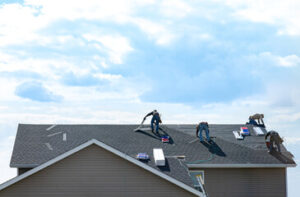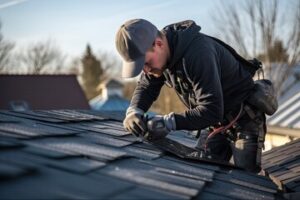Roof Repair Massachusetts is an important part of keeping your home in good condition. Whether you need to fix a few leaky spots or replace damaged shingles, a professional should be able to assess your roof and recommend the right solution for your needs.
If you have a water stain on your ceiling, start by finding the source of the leak. This may require going into your attic and following the trail of water damage.
Repairing Damaged Shingles

Shingles are a crucial part of the roofing system that protects your roof from moisture. Even minor damage can lead to leaks, and this is one of the most common reasons homeowners need roof repair services. You can do a lot to prevent shingle damage by regularly inspecting your roof and performing routine maintenance. However, if you notice that your shingles are damaged or missing, it’s important to hire a professional to make repairs right away.
Roofing companies can identify the cause of the problem and perform quick and easy repairs to fix it. They can also determine whether your roof needs a replacement or if it is still in good condition and can serve you for many more years.
Inspecting your shingles regularly is essential for home ownership. Look for any signs of damage or wear and tear such as curling or buckling, as these can indicate that your roof is overdue for a replacement. Other indicators of a bad roof include water stains and sagging of the decking. Leaks are the most common reason for roof repair, and this could be due to cracked shingles or damage to flashing.
Roof shingles are made of a variety of materials, and different types of shingles have different expected lifespans. A well-maintained shingle roof can last 15 to 25 years before needing a replacement.
When repairing damaged shingles, the first step is to gather all necessary tools and materials. This includes safety gear like a sturdy ladder, a harness, and gloves, as well as a utility knife, a hammer, roofing nails, and roof cement. A caulking gun is also a must, as it can be used to seal the edges of your repaired shingles.
Once you’ve gathered all your supplies, you can start preparing to replace the damaged shingle. To do this, you’ll need to loosen the shingle above it by sliding the pry bar underneath and lifting up. Next, lift the shingle and remove any nails it is secured with. Once the shingle is removed, you can slide in the new shingle and secure it with roofing cement and nails.
Repairing Damaged Flashing
Flashing is a crucial part of roof installation that seals vulnerable areas like joints, valleys, and around chimneys or vents. It safeguards these areas from water infiltration that can lead to costly repairs and structural damage to the home. Properly installed flashing should be fastened to the roof, overlapping adjacent roofing materials for a watertight seal. It also needs to be regularly inspected for signs of wear and tear that can lead to leaks or other problems.
Common flashing issues include rust or corrosion, cracks and gaps, and loose or missing sections. These issues can be caused by weather conditions, thermal expansion and contraction, or improper flashing installation. In these cases, it is important to identify the issue and make prompt flashing repair to prevent further damage to the roof and the home.
Leaks and water stains are the most obvious signs of flashing problems, as these indicate that the flashing is no longer providing an effective barrier to moisture. Water infiltration can lead to mold growth, rotted wood, and other serious structural damage. Ignoring flashing issues can also cause sagging of the roof and weakening of support structures in the house.
While some minor flashing issues can be repaired by homeowners, complex repairs should always be left to professional roofers. They have the knowledge, skills, and specialized equipment necessary to work safely at heights and in hard-to-reach areas. In addition, professional roofers can help identify any underlying issues that may require further attention and maintenance.
Before starting a flashing repair project, it is important to prepare for the job by gathering the proper tools and materials. Essential items include a pry bar, utility knife, caulking gun, roofing cement, and replacement flashing. It is also important to have a sturdy ladder and safety gear, including a pair of gloves, safety glasses, and a harness. Detailed preparation will help ensure a smooth, efficient repair process and a quality result. Once the flashing is replaced, a high-quality roof sealant should be applied to create an additional layer of protection against moisture infiltration. The sealant should be specifically designed for roofing applications and be applied according to manufacturer instructions for optimal results.
Repairing Damaged Gutters and Downspouts
Gutter systems perform a vital function for the roof. They collect rainwater and move it away from the home to prevent water infiltration, which can damage fascia boards, walls, and foundations. They are also important for preventing rot and mold. However, as gutters age, they can become damaged or clogged. If these issues are not addressed, they can cause extensive water damage to the roof and home. Homeowners in Tampa can perform some basic repairs to their gutters and downspouts to avoid costly roof repair in the future.
A common issue with gutters is rust. This happens when metal gutters come into contact with moisture and dirt. This causes the metal to corrode, which can create holes and weaken the system. Homeowners can prevent rust by cleaning their gutters regularly and applying a coat of rust-inhibiting paint when they do so. Homeowners can also fix small rust spots using gutter repair tape. If a gutter is very rusty, homeowners should consider replacing it altogether.
Other issues with gutters include leaks, sagging, and clogs. Leaks are often indicated by stains on the ceiling or walls. If left untreated, this can lead to severe damage and wood rot within the home. Gutter leaks can also be caused by warped or corroded sections. Roofing professionals may install additional drainage points to help with drainage or make slight modifications to the slope of the roof to prevent ponding.
If a gutter is sagging, it’s likely that the hangers are loose or have become bent. Homeowners can replace the old hangers with new ones to prevent further damage and secure the gutters to the house. Gutter clogs are usually caused by debris and need to be cleared out before they can be fixed. A plumber’s snake can be used to clear out large clogs.
If the downspout becomes detached, it’s important to reattach it as soon as possible. Detached downspouts can result in water infiltration, which can damage the fascia board and walls. This is often caused by a buildup of leaves or other debris. Homeowners can reattach a downspout using gutter screws and sealant.
Repairing Damaged Skylights
Skylights bring natural light and a connection to the outdoors into rooms of your home, but they can also be a source of water damage if not properly maintained. If you have a leaky skylight, it’s important to take immediate action to avoid costly repair costs down the road. Common signs of skylight leaks include stains around the frame and glass, unusual sounds during rainfall, or drafts near the skylight.
Skylight repairs can be complex and vary in cost depending on the type of skylight and its location on your roof. The most common types are fixed, ventilating, and tubular skylights. Fixed skylights are designed to provide natural lighting without the ability to open, whereas vented skylights can be opened to allow ventilation and sunlight into rooms. Ventilating and tubular skylights have moving parts that can break down over time, causing leaks or condensation problems.
The most significant factor in determining the cost of skylight repairs is the extent of the damage. The most minor issues can be addressed by resealing the seal and flashing with roofing caulk, while larger repairs may require replacing the entire skylight or its flashing. The pitch of your roof will also affect the total cost of the repair job. Steeper roofs generally incur higher repair costs because they are more difficult to work on.
While it’s possible to tackle some skylight repair projects on your own, it’s usually best to leave the repairs to a professional roofer to prevent further damage and save you money in the long run. If you’re considering doing some DIY roof repair, be sure to wear appropriate safety gear and follow a safe procedure for climbing on your roof. A fall from even 6 feet can cause severe injury or death.
When choosing a roofer for skylight repair, ask for references from previous clients and check their reputation. It’s also a good idea to choose a contractor who provides written contracts, warranties, and detailed descriptions of the work to be performed. Lastly, effective communication is crucial throughout the duration of the project.

